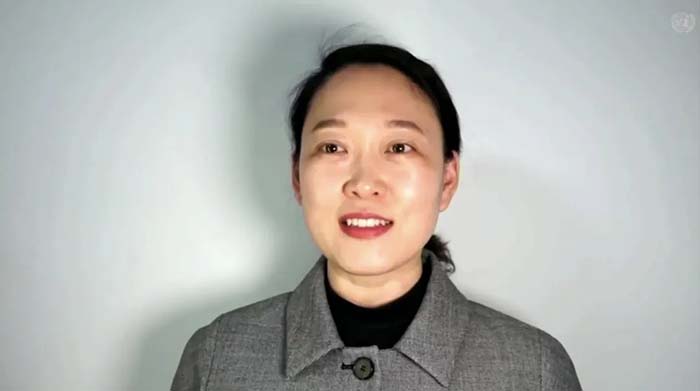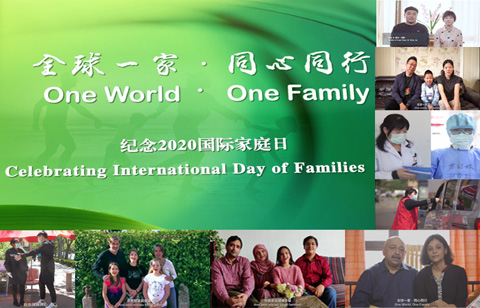2021 Yearly Statistical Monitoring Report on the Implementation of China National Program for Women's Development (2021-2030)
Date:2023-4-24 16:11:58 Views:2021 Yearly Statistical Monitoring Report on the Implementation of China National Program for Women's Development (2021-2030)
China has made great strides in the improvement of women's and children's access to health, education and social security and the protection of their rights and interests, according to the yearly statistical monitoring reports on the implementation of the China National Program for Women's Development (2021-2030) and the China National Program for Child Development (2021-2030) in 2021. The reports were released by the National Bureau of Statistics (NBS) on April 20.
2021 was the first year to implement the China National Program for Women's Development (2021-2030). The NBS has conducted comprehensive analyses over progress made in the areas of health, education, economy, participation in decision making and management, social security, family building, environment and law. The results show that the implementation of the national program was smooth in 2021. The health of women and women’s education level has improved. Women’s economic and social status have improved and the coverage of social security has expanded, with a complete legal security system for rights protection established.
1. Women and Health
(1) Women's health condition has steadily improved. In 2021, the maternal mortality ratio was 16.1 per 100,000 lives, which was 4.7 percent lower than that in 2020. The maternal mortality rate in urban and rural areas stood at 15.4 per 100,000 lives and 16.5 per 100,000 lives in 2021. The rural-urban gap decreased from a factor of 4.4 per 100,000 lives in 2020 to 1.1 per 100,000 lives in 2021.
(2) The full-life-cycle health services for women have been provided. In 2021, a special initiative was implemented to guarantee the health and safety of women and newborns through five mechanisms. More efforts have been made to improve whole-process child birth services, health services to those in adolescence and menopause, and to prevent major diseases such as cervical and breast cancer. In 2021, the rate of pre-marital medical examination came in at 70.9 percent , up 2.5 percentage point compare with that in 2020. The systematic management rate for maternal care and the antenatal screening coverage was 92.9 percent and 85.7 percent respectively, an increase of 0.2 and 4.6 percentage points from 2020. The hospital delivery rate has maintained over 99 percent. The postnatal care coverage grew by 0.5 percentage point to 96 percent in 2021.
(3) The rate of mother-to-child transmission of HIV/AIDS has further gone down. The country adopted a three-year action plan (2019-2022) to strengthen the prevention and control of mother-to-child transmission of HIV/AIDS. In 2021, the rate was 3.3 percent, down 0.3 percentage point from 2020.
2. Women and Education
(1)The gender gap in compulsory education has been basically eliminated. The country has intensified its efforts to promote the balanced development of compulsory education and guarantee girls’ rights to equal access to compulsory education. In 2021, the net enrollment rate of primary school-age girls remained above 99.9 percent, which was virtually the same as that of boys. There were 73.67 million female students enrolled in the nine-year compulsory education stage, an increase of 817,000 since 2020, accounting for 46.6 percent of the total number of students in school, the same level in 2020.
(2) Equal access to senior secondary education has been consolidated for girls. In 2021, a national action was carried out to advance the level of universalization of senior secondary education in all counties during the 14th Five-year Plan period (2021-2025), which strengthened girls’ access to senior secondary education. In 2021, there were 20.598 million girls enrolled in senior secondary education, accounting for 46.8 percent of the total, or the same level to that in 2020. Among them, 13.08 million enrolled in regular senior secondary schools, an increase of 506,000 people and accounting for 50.2 percent. The figure has remained above 50 percent for seven consecutive years.
(3) A rising number of women have been receiving vocational education. In 2021, the country released a set of guidelines on promoting the high-quality development of modern vocational education . There were 7.26 million women receiving secondary vocational education, accounting for 41.8 percent of the total and an increase of 366,000 or 0.3 percentage points from 2020. There were 7.48 million women studying at vocational universities, making up 46.7 percent of the total student body.
(4) The percentage of women in all forms of higher education has continuously exceeded 50 percent. The opportunities for women to receive higher education have continued to increase. In 2021, there were 27.8 million female students enrolled in higher education, accounting for 50.2 percent and an increase of 1.24 million from 2020. Among them, there were 1.72 million graduate students, accounting for 51.5 percent and an increase of 0.6 percentage points. The number of female students enrolled in colleges/universities and adult programs in colleges/universities was 17.56 million and 4.8 million, accounting for 50.2 percent and 57.7 percent respectively.
3. Women and Economy
(1) Women account for over 40 percent of the employed population. The country has taken actions to fully guarantee gender equality and eliminate discrimination in employment. In 2021, the total number of women employed nationwide was about 320 million, accounting for 43.1 percent of the total employed population. In urban work units, the number of women employed was 68.52 million, or 40.3 percent of the total in this category, an increase of 0.5 percentage point from 2020.
(2) Labor protection for female employees has been continuously strengthened. The publicity and implementation of the Special Provisions on Labor Protection for Female Employees have been highlighted, raising the awareness of both employers and women in terms of labor protection and safe production and upholding lawful rights and special interests of female employees. In 2021. the proportion of enterprises implementing the special provisions reached 73.3 percent, a 2 percentage points increase from 2020.
4. Women's Participation in Decision-making and Management
(1) The selection and cultivation of female officials have been strengthened. In 2021, the proportion of provincial-, municipal- and county-level governments that had women heads in their leadership was 6.5 percent, 8.4 percent and 10.6 percent respectively. The proportion of provincial-level, municipal-level and county-level governments that had women in their leadership was 61.3 percent, 86.5 percent and 96 percent respectively. The proportion of government departments at provincial, municipal and county levels that had women heads in leadership was 10.1 percent, 14 percent and 12.3 percent respectively, up 0.2 percentage points, 0.9 percentage points and 0.7 percentage points respectively from 2020. The proportion of government departments at provincial, municipal and county levels that had women in the leadership of was 53.6 percent, 55.7 percent and 50.8 percent respectively, an increase of 0.2 percentage points, 1.2 percentage points and 0.8 percentage points respectively from 2020.
(2) Women have become widely involved in decision-making of enterprises. The reform of personnel system in firms has been deepened, which enabled outstanding women to enter the boards of directors, boards of supervisors and the management personnel of enterprises, and expanded women’s participation in management. In 2021, the proportion of females on the boards of directors and boards of supervisors of enterprises were 37.6 percent and 40.5 percent, respectively, an increase of 2.7 percentage points and 2.3 percentage points since 2020. The proportion of female representatives in the workers’ congress of enterprises was 30.6 percent, up 0.4 percentage points from 2020.
(3) Women's participation in grassroots social governance has markedly improved. The proportions of female members in residents’ committees and villagers’ committees have increased. The proportions of female members in residents’ committees and villagers’ committees was 54.4 percent and 26.8 percent respectively in 2021, an increase of 2.3 percentage points and 2.6 percentage points from 2020. Women accounted for 41.4 percent and 11.1 percent of directors of residents’ and villagers’ committees respectively, up 2.4 percentage points and 1.3 percentage points from 2020.
(4) The influence of women in social organizations keeps growing. The country has encouraged more women to take part in the management and development of social organizations. The proportion of female employees in social organizations was 39.2 percent in 2021, an increase of 2.2 percentage points from 2020. The proportion of women acting as heads of social organizations was 26.7 percent in 2021.
5. Women and Social Security
(1) The number of women participating in basic medical insurance has continuously grown. A rising number of female employees and women in both rural and urban areas have been covered with basic medical insurance. At the end of 2020, 660 million women participated in basic medical insurance, an increase of 8.2 million people from that of end 2020. Among them, 170 million women participated in basic medical insurance for urban employees and 490 million participated in basic medical insurance for urban and rural residents, an increase of 7.89 million and 318,000 respectively that of end 2020.
(2) Women entitled to basic pension insurance were largely covered. Efforts to realize full coverage of social insurance for age-appropriate residents have been intensified and those who have not participated in basic pension insurance for urban employees have been organized to participate in basic pension insurance for urban and rural residents. In 2021, 490 million women participate in basic pension insurance, an increase of 18.97 million since end 2020. Among them, 230 million women participated in basic pension insurance for urban employees, an increase of 17.98 million from end 2020, and 260 million women participated in basic pension insurance for urban and rural residents, an increase of 991,000 from end 2020.
(3) More women participated in maternity, unemployment and work-related injury insurance. With the combination of maternity insurance with basic medical insurance for employees, and the improvement of all types of insurance systems, women's lawful rights and interests related to insurance have been guaranteed. At the end of 2021, 105 million women participated in maternity insurance, an increase of 1.59 million since end 2020. A total of 98.16 million women participated in unemployment insurance, an increase of 6.09 million, and 106 million women participated in work-related injury insurance, an increase of 3.61 million from end 2020.
(4) Assistance to women facing various difficulties have been steadily improved. The country has further consolidated and expanded its achievements in poverty alleviation and ensured basic needs of people facing various difficulties. In 2021, the subsistence allowances for urban and rural recipients on average were 711.4 yuan ($ 102.9) per month and 530.2 yuan ($ 76.7) per month, up 5 percent and 6.7 percent from 2020. There were 46.82 million people living on subsistence allowances or in difficulties. Among them, there were 20.246 million women, accounting for 43.2 percent, an increase of 0.4 percentage points from 2020.
(5) The supply of elderly care services has been improved. In 2021, the country adopted a proactive national strategy in response to population aging, promoted the innovative development of home- and community-based elderly care, and improved its elderly care service system. At the end of 2021, there were 733,000 women receiving services in elderly care institutions, an increase of 50,000 from end 2020. Meanwhile, the number of community-based care service institutions and facilities for elderly people was 318,000, an increase of 26,000 from 2020.
6. Women and Family Building
(1) Policies and measures to support family development have been improving. Many places around the country have revised their population and family planning regulations, rolled out childbirth supportive measures in tax cuts, education, housing and employment, and explored more approaches to ease the burden of childbearing.
(2) The country has further strengthened family building, family education and traditions by promoting the family-oriented ethical progress, encouraging family members to fulfill their social duties, and carrying out the Family Happiness and Well-being Campaign. In 2021, women's federations, at all levels, nationwide awarded 49,858 model households, recommended 1.78 million families during the looking for most beautiful families campaign, and conducted 113,000 lectures on revolutionary stories and traditions to 34 million audience.
7. Women and Environment
(1) Women have enjoyed better access to safe drinking water. In 2021, the Communist Party of China (CPC) Central Committee and the State Council issued a circular on further promoting the nationwide battle to prevent and control pollution. The circular has fundamentally advanced the standard protection of drinking water sources for urban and rural residents. In 2021, water quality of 94.2 percent of centralized drinking water sources at the prefecture level and above reached the national standard. The penetration rate of rural tap water was 84 percent, up one percentage points from 2020.
(2) Women have enjoyed better access to sanitary toilets in rural areas. In 2021, a five-year (2021-2025) action plan on improving rural living environment was released to promote the toilet revolution, which helped increase the access to sanitary toilets and improve living environment of rural residents. The access to sanitary toilets surpassed 70 percent at the end 2021.
8. Women and Law
(1) The prevention and prohibition of domestic violence has markedly improved. Since the implementation of the anti-domestic violence law, in March 2016, the country has adopted concrete intervention measures such as compulsory reporting, admonition from public security organs, and protection from anti-family violence sheltering centers, and improved the law system against domestic violence. In 2021, 2,530 restraining orders have been issued to protect women’s personal safety.
(2) Progress has been made in cracking down on crimes against women. In 2021, the State Council issued an action plan against human trafficking (2021-2030) to redouble efforts in the prevention and control of human trafficking, sexual assaults and organized prostitution. Statistics show that 251 cases of abducting and trafficking in women were uncovered; 35,000 rape cases and 15,000 cases of organizing, forcing, seducing, providing shelter for and introducing prostitution were closed, and there were 88 cases of disputes over liability for sexual harassment-related damage.
(3) The availability of public legal services for women has been enhanced. The legal aid and judicial assistance systems have been improved, and women’s awareness of rights protection has been raised. As of the end of 2021, there were 2,629 legal aid institutions and 75,000 legal aid stations across the country. In 2021, legal aid services were provided 329,000 person-times to women. Meanwhile, the number of women receiving judicial assistance from people’s courts, people’s procuratorates and government organs was 16,000, 16,000 and 141 respectively in 2021. Women's federations at or above county level responded to complaints from women and children a total of 179,000 times.



